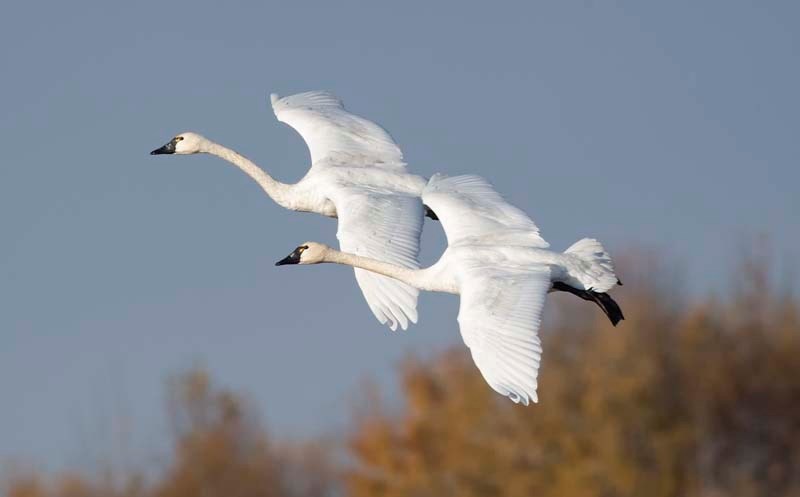A few weeks ago, I happened to hear what sounded like a troupe of travelling trumpeters soaring overhead. Looking up, I realized that it was yet another V-shaped flock of geese flying south for the winter. Except something was off about these ones.
A few weeks ago, I happened to hear what sounded like a troupe of travelling trumpeters soaring overhead. Looking up, I realized that it was yet another V-shaped flock of geese flying south for the winter.
Except something was off about these ones. For one, they sounded too high-pitched for geese – more like a bugle than a horn. For another, they looked all white instead of grey.
Local birder Alan Hingston says those were probably swans rather than geese – specifically, tundra swans. "The vanguard of the swan migration is just arriving," he says, and there will soon be thousands of them in local lakes and rivers – up to 20,000 on Big Lake alone. "In the next four to six weeks, we'll see a big build-up."
The tundra swan is the most common swan in North America, Hinterland Who's Who reports, with about 140,000 of them thought to live on the continent. They mate in the Arctic and winter in the U.S., so the only time we see them here in St. Albert is during migration.
Apart from their black feet and beaks, tundra swans are pure white, says Lee Foote, a conservation biologist at the University of Alberta, and are the second biggest all-white swans in Alberta.
They look very close to snow geese, Foote says, except snow geese have black wing tips and sound more like yelping dogs.
And they look virtually identical to trumpeter swans, he adds, which are much more rare and also protected under provincial law. They look so alike, in fact, that you can't legally hunt tundras in Alberta, since you might shoot a trumpeter.
It's very tough to tell the two apart, Hingston says, especially since they're usually way out in the water. Tundra swans usually have a big yellow spot under their eyes on their beak that the trumpeters lack, but some do not. Trumpeters also have a deeper, more trumpet-like call than the tundras, he continues, and are about 25 per cent bigger.
Most birders shouldn't sweat the details, he says. "Odds are, you're looking at a tundra," he says. "Just be happy that they're there in good numbers."
If you see a tundra swan with a rusty-coloured head, you'll know that it spent its summer in Alaska. Tundras are dabblers, and the iron-rich waters of Alaska stain their heads red.
Tundra swans are some of the first to return and last to leave when it comes to migration, Foote says, staying just ahead of the ice. Sick or old ones may stay too long and die trapped in the ice, he notes – at least one was reported to have suffered that fate on Big Lake last November.
Tundra swans will spend the winter in either Virginia or California, Foote says, with the split point in their migration being right over Alberta. This is likely because the young birds learn migration routes from their parents, he says, and stick with them out of tradition.
You'll most likely see tundras on the move early in the morning or evening, Foote says, as they migrate by night. They'll spend their days using their long necks to munch plants at the bottom of places like Big Lake, often gouging big pits in the lakebed in the process. You'll sometimes see American coots snatching food right from the swans' beaks to take advantage of the bird's better reach.
Tundra swans are normally quite docile, Foote says, but heaven help you if you disturb one on a nest – they'll get super-aggressive and slam you with their wings hard enough to shatter bones. "They'll smack the tar out of you."
Big Lake is a great place to see tundra swans at this time of year, Hingston says, particularly if you go to the west side where it meets the Sturgeon River. Bring a telescope, though, as they'll be pretty far away.
Hingston says he's a big fan of the birds. "The sight of a flock of swans going over Big Lake against the blue sky like this is quite a spectacular sighting."
Tundra swan
Name:<br />Cygnus columbianus.<br /><br />Appearance: <br />Big white swan with black beak and feet, plus a yellow spot below the eye on the beak.<br /> <br />Commonly seen:<br />Flying overhead in V-formation or eating plants on Big Lake.<br /><br />Occasionally confused with:<br />Snow geese, which have black wingtips, and trumpeter swans, which usually don't have a yellow spot on their beak.<br /><br />Fun fact:<br />They can reach speeds of about 160 kilometres an hour with a tailwind.
Wild St. Albert
Like wildlife? So do we! Every second Wednesday the Gazette profiles a reasonably common wild creature in the St. Albert region. Birds, beasts, bugs, fish … so long as it's alive and kicking, we'll feature it. <br /><br />Got a creature you'd like to see profiled? Send your suggestions to [email protected].




